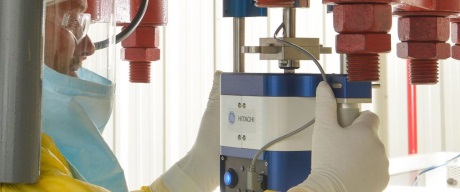GE Hitachi unveils remote uncoupling tool
25 March 2015
GE Hitachi Nuclear Energy (GEH) has unveiled a remotely-operated tool that enables nuclear technicians to complete tasks at the bottom of nuclear reactors more quickly and safely. The tool has been shown to reduce radiation dose associated with uncoupling control rods from their associated blades by as much as 60%.
 |
| A technician operates the remote uncoupling tool at GE Hitachi's under vessel training facility in Wilmington, North Carolina (Image: GE Hitachi) |
The battery-powered, wireless device is "unique in the industry", Kevin Walsh, GEH senior vice president for nuclear services and fuels, said today. "It is also an important illustration of our use of 3-D printing technologies, speeding our time to market by months and eliminating the significant expense of fabricating metallic mock ups."
Based on 3-D printed prototypes created on-site at GEH's headquarters in Wilmington, North Carolina, the tool has been successfully deployed during recent maintenance work at the Dresden Generating Station in Morris, Illinois. and the Peach Bottom Atomic Power Station in Delta, Pennsylvania.
A total of 19 drives were uncoupled with the tool at Peach Bottom and 25 were uncoupled at Dresden. The plants are operated by Exelon Generation which operates the largest nuclear fleet in the USA.
Exelon senior vice president Dave Rhodes, who oversees refueling activities across the 14 nuclear plants Exelon operates, said the tool "adds another layer of safety to our work process".
Control rod blades are long, cruciform metal-tube components that contain neutron-absorbing material and are positioned adjacent to nuclear fuel assemblies within the reactor core. Operators remotely adjust the position of these blades to manage power generation.
In order to remove control rod blades during service outages the blades must be uncoupled from drive mechanisms underneath the reactor pressure vessel. Any blades that are not successfully uncoupled from underneath the vessel must be uncoupled from a refueling floor above the vessel, a more time consuming process.
The tool's effectiveness meant it was not necessary to conduct any uncoupling from the refueling floor during the Dresden and Peach Bottom outages, GEH said. It replaces a much more labor-intensive process involving floor jacks and the removal of large quantities of steel plates.
Researched and written
by World Nuclear News